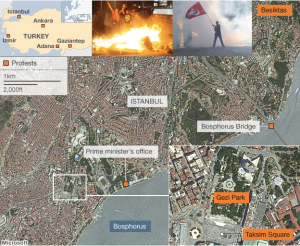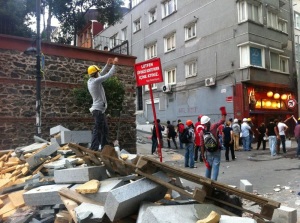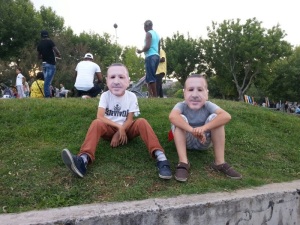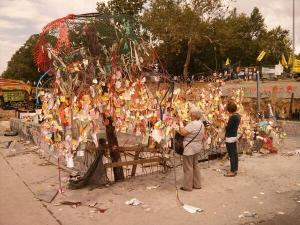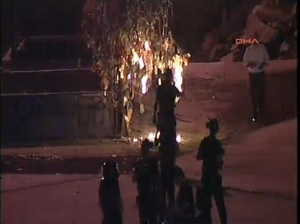Starting during the day and continuing into the wee hours of Wednesday (June 12) morning, police disbursed the thousands of protestors who had gathered at Taksim square and Gezi park in the fortnight long series of gatherings which began as an effort to stop the removal of trees and has morphed into a public show of opposition. Today (12 June 2013), Prime Minister Erdogan is due to meet with representatives of those who have been protesting. Dialogue is a good thing, but dialogue with an outcome is even better. So what options are on the table? Demonstrators have a few, stated last week: that plans to reconstruct the park be stopped, that police use of force be held to account and that tear gas be banned.
The 11 or so representatives (at writing) had not yet been identified by the media. Who do they represent and have these demands changed? What are the demands of the government? With the lack of clear, enunciated objectives, what will be that middle ground, what will be the fruits of these demonstrations?
 In chants, graffiti and memes in Istanbul, Ankara and elsewhere, calls for the Prime Minister to resign, and even the government to step down are unrealistic. Prime Minister Erdogan has come to power on a majority, popular vote. He has also done this by increasing the share of the vote in each subsequent election. That means there is a majority in the country who support him. However there are his supporters who are also critical of the way these protests have been handled. Crowds have come onto the street as an affront to police use of force, but remember the saying “violence begets violence”? All it takes is a few bad apples, a few provocateurs to start throwing stones, Molotov’s and the like for police to not respond in kind, but overwhelmingly. When that happens, more defiant crowds emerge, until one side wears down, coalesces or a middle ground is reached. That doesn’t seem to be happening on either side. Protestors may have the numbers but police have the dispersants. Its not an even match whichever way you look at it. The resistant crowd is labelled as violent, troublesome and must be stopped at any cost. The police are just doing their job, it can be argued, in a country where many in those ranks have little options available, where even standing down creates serious moral and livelihood ambiguity. I have previously written that Turkey is a country of polar opposites. There is hardly a middle ground – whether in sport, politics or even media.
In chants, graffiti and memes in Istanbul, Ankara and elsewhere, calls for the Prime Minister to resign, and even the government to step down are unrealistic. Prime Minister Erdogan has come to power on a majority, popular vote. He has also done this by increasing the share of the vote in each subsequent election. That means there is a majority in the country who support him. However there are his supporters who are also critical of the way these protests have been handled. Crowds have come onto the street as an affront to police use of force, but remember the saying “violence begets violence”? All it takes is a few bad apples, a few provocateurs to start throwing stones, Molotov’s and the like for police to not respond in kind, but overwhelmingly. When that happens, more defiant crowds emerge, until one side wears down, coalesces or a middle ground is reached. That doesn’t seem to be happening on either side. Protestors may have the numbers but police have the dispersants. Its not an even match whichever way you look at it. The resistant crowd is labelled as violent, troublesome and must be stopped at any cost. The police are just doing their job, it can be argued, in a country where many in those ranks have little options available, where even standing down creates serious moral and livelihood ambiguity. I have previously written that Turkey is a country of polar opposites. There is hardly a middle ground – whether in sport, politics or even media.
In Istanbul last night, a massive disbursement of tear gas and water cannons cleared protesters, and the public space. This was all, apparently without any repeated, audible or clear goals for the crowds to do so. The only announcement it seemed was from Istanbul’s Governor, sending messages over Twitter. The result of this was to effectively remove the possibility for people to congregate. Barriers were removed and ‘order’ restored. The Taksim underground stop is functioning again and after almost two weeks, municipality buses are returning to the square. Cars are trickling into what is one of the busiest spots in Istanbul and indeed, Turkey.
Where do the protests go from here? The second obvious destination of protest is the Prime Ministers offices in Istanbul – these are down the hill from Taksim. In the early nights of the clashes this was a scene of tense police-protestor standoff. After a construction vehicle was used as a shield to approach the building, police would have taken the necessary steps to limit gatherings and disruption and secure the safety of this space. This is what the clearing Taksim tactic is also about: removing a focus and mobilisation point, forcing a return to ordinary life by clean ups and traffic returns. At writing, there were attempts to also nudge out the peaceful protestors who had been living (or occupying) Gezi park, again to diffuse mobilisation. Ankara is facing the same. Campers in Kugulu park, which has been the assembly point before marching down to Kizilay, were standing off between occupying the space and police removal.

Kizilay, Ankara
The past few days in Gezi park have been a communal peaceful gathering. Provocateurs have been identified, outed and confrontations subdued. Commentary about the park was hopeful: there was yoga in the park, a bookshop set up, triage tents, facilities and the like. Although tear gas from the perimeters and police moving in caused disruption, protesters were there again today, repairing, resisting. It is important to remember that there is not one group claiming responsibility for the protests or for their organisation. This has been a largely organic movement with people from all walks of life beginning with students, lawyers, celebrities and even government workers (who inducted a 2 day strike last week), who have all come out against the heavy handedness of the police (which has been acknowledged and apologised for by President Gul and Deputy Prime Minister Arinc), and lack of reconciliation between protestors objectives and outcomes.
A new Ottomanism? No.
Hopefully, most mainstream media should have picked up that the protests in Turkey are not a “Turkish Spring” – in other words, they are not similar to the movements leading to the topple of various Arab regimes by mass popular protest in 2011. There are too many social and political differences to draw parallels. One nagging reference that is used incorrectly is correlating Erdogan and his government in some exercise in rekindling “Ottomanism”. The Ottoman Empire spanned some 600 years. It prefaced today’s conception of nation states and like every global power had high and low points. The apex of the empire was in the 16th century under the reign of Sultan Suleyman, whose rule was marked not just by expansion, military prowess and state patronage of arts, but also by justice. What ebbed at the empire and contributed in its decline were economic dependency on the West, growing corruption, weakened military and the growth of nationalism which fractured the concept of allegiance to the Sultan, and to the Empire. Comparing Erdogan to various Sultans are as accurate as comparing oneself to tracing ones family genealogy and identifying character traits. Turkey’s foreign policy of engaging with the immediate neighbourhood: Arab states, the Balkans and the like are not out of international relations order. They are pragmatic.
No one stop democracy shop
Turkey is a democracy in the region, one that has been referred to time and again as the example to be looked up to in the blending of the accommodation of religion within a secular political context. But we should also remember that democracy is an ongoing process and there are variations within it. It is incorrect to assume that Turkey is a democracy to the same degree as developed Western societies. Turkey is still classified as a middle income developing country, which means that as it grows, it will continue to have growing pains. Does this justify media censorship or use of force however? Does media coverage equate to inciting violence? Do citizens updating social media in a media void of covering events relate to incendiary speech? Does civil disobedience represent legitimate democratic displays or are they nuisances to be dealt with by the law? In the days, weeks and months that follow, it is that very dialogue between diverse actors that will find the answers to these questions. A democracy develops when opposing voices are able to come to together to develop negotiated outcomes. Democracy falters when everyone simply starts nodding, not questioning or discussing. There are preconditions for this also. Elections, when fair, with high voter turnout are the most efficient democratic display. But to address all the underlying questions, critical education, broad dialogue and development are also key. Not all these preconditions could be said to be met yet in Turkey. That’s why Turkey is still a candidate EU country – it is on track to fulfilling criteria, its not quite there yet.
What happens now
 Although all looks calm at writing, there is one key date that the government will likely want demonstrations to settle by, and that is July 8. That date marks the start of Ramadan, the holiest month in the Muslim calendar, which moves up by one month every year, as is based on the lunar calendar. This month is not simply a time from abstaining from food and drink between sunrise and sunset, but it is a time of deep spiritual reflection, a time to mend interpersonal wounds, and definitely not a time to use force against protestors. Doing so would create a serious moral predicament for the government. Why does this matter? While some Western media still display traces of naming and analysing the demonstrations as Islamism versus secularism or authoritarianism against democracy, remember that a majority of the population voted in the government and approves of the Prime Ministers rule. However this base does risk alienation if innocents are targeted or affected by ongoing violence. It is erroneous to classify all protestors as societal miscreants or deviants. The group is too big and diverse for that. Those who were apathetic or apolitical to protests have also been drawn in. Think of these cases: store owners and workers who have had their premises damaged, had to close due to safety risks and have serious threats to income considering Turkey is just entering peak annual tourist season. Think of the neighbourhoods. Major Turkish cities are population dense – that means within tens of metres of key protests points lie apartment buildings. People not able to enter or leave their homes easily and are subject to tear gas and if not that, the noise which lingers into the wee hours of every morning for the past 2 weeks. These people are unwitting bystanders, and fairly, would be expected to be drawn into or at least have an opinion of what’s going on.
Although all looks calm at writing, there is one key date that the government will likely want demonstrations to settle by, and that is July 8. That date marks the start of Ramadan, the holiest month in the Muslim calendar, which moves up by one month every year, as is based on the lunar calendar. This month is not simply a time from abstaining from food and drink between sunrise and sunset, but it is a time of deep spiritual reflection, a time to mend interpersonal wounds, and definitely not a time to use force against protestors. Doing so would create a serious moral predicament for the government. Why does this matter? While some Western media still display traces of naming and analysing the demonstrations as Islamism versus secularism or authoritarianism against democracy, remember that a majority of the population voted in the government and approves of the Prime Ministers rule. However this base does risk alienation if innocents are targeted or affected by ongoing violence. It is erroneous to classify all protestors as societal miscreants or deviants. The group is too big and diverse for that. Those who were apathetic or apolitical to protests have also been drawn in. Think of these cases: store owners and workers who have had their premises damaged, had to close due to safety risks and have serious threats to income considering Turkey is just entering peak annual tourist season. Think of the neighbourhoods. Major Turkish cities are population dense – that means within tens of metres of key protests points lie apartment buildings. People not able to enter or leave their homes easily and are subject to tear gas and if not that, the noise which lingers into the wee hours of every morning for the past 2 weeks. These people are unwitting bystanders, and fairly, would be expected to be drawn into or at least have an opinion of what’s going on.
 Hopes of solidarity, a coming of age moment especially in a country where half the population is under the age of 30 are being quickly dashed. But we can also see why. One role of the government is to maintain social order. Sure, the converse is citizens have a right to freedom of assembly and protest, though not a right to cause public destruction. It becomes a chicken and egg scenario. Is public damage a consequence of police use of force? Or is it the ammunition for it? The sound of chirping birds have replaced the mass chants in Taksim on live streams. As storm clouds gather on Istanbul, only time will tell whether this peace, albeit imposed will hold.
Hopes of solidarity, a coming of age moment especially in a country where half the population is under the age of 30 are being quickly dashed. But we can also see why. One role of the government is to maintain social order. Sure, the converse is citizens have a right to freedom of assembly and protest, though not a right to cause public destruction. It becomes a chicken and egg scenario. Is public damage a consequence of police use of force? Or is it the ammunition for it? The sound of chirping birds have replaced the mass chants in Taksim on live streams. As storm clouds gather on Istanbul, only time will tell whether this peace, albeit imposed will hold.

